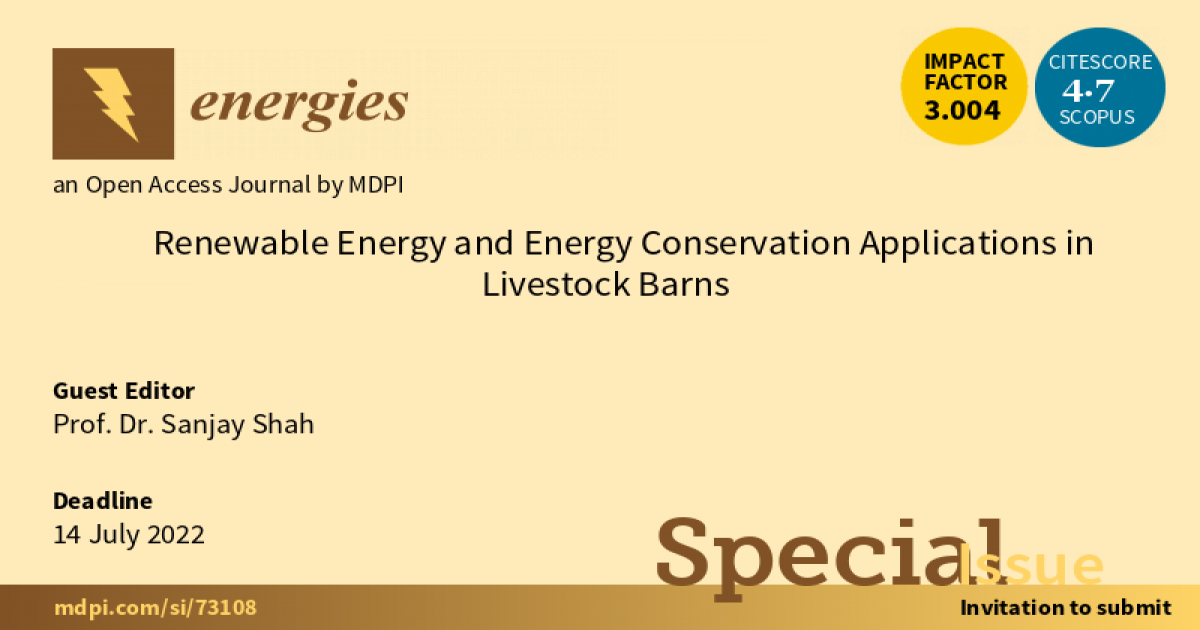Renewable Energy and Energy Conservation Applications in Livestock Barns
A special issue of Energies (ISSN 1996-1073). This special issue belongs to the section "B: Energy and Environment".
Deadline for manuscript submissions: closed (14 July 2022) | Viewed by 11618

Special Issue Editor
Interests: livestock barn ventilation; heating and cooling; agricultural air quality; renewable energy applications in livestock barns
Special Issues, Collections and Topics in MDPI journals
Special Issue Information
Dear Colleagues,
You are invited to publish your original research in this Special Issue, which highlights the use of renewable energy and energy conservation in livestock production. While this topic is also covered in other science and engineering journals, we seek to provide comprehensive coverage of cutting-edge research on this important topic in a single issue. Consequently, we hope that this Special Issue will be useful for not only researchers (animal scientists, engineers, economists) but also manufacturers, policy makers, and commodity groups, leading to greater cooperation and application of renewable energy and energy conservation in livestock production.
Topics of interest include, but are not limited to:
- Experimental evaluation of renewable energy and energy conservation in livestock production
- Modeling of renewable energy/energy conservation system/s in livestock production
- Economics of renewable energy/energy conservation system/s in livestock production
- Renewable energy impacts on air quality (indoor or ambient), animal welfare, and/or performance
Here, renewable energy is defined to broadly encompass on-farm applications of solar thermal, photovoltaic, wind, biomass, geothermal, wave/tidal, hydroelectric, and hydrogen energies. The scope of this Special Issue does not include studies on materials that might be used to generate renewable energy. This Special Issue will publish original research (including case studies) and invited review papers. Review papers will only be accepted by invitation of the Guest Editor; interested researchers should submit an outline of the review paper (including justification) and a short CV to the Guest Editor.
Prof. Dr. Sanjay Shah
Guest Editor
Manuscript Submission Information
Manuscripts should be submitted online at www.mdpi.com by registering and logging in to this website. Once you are registered, click here to go to the submission form. Manuscripts can be submitted until the deadline. All submissions that pass pre-check are peer-reviewed. Accepted papers will be published continuously in the journal (as soon as accepted) and will be listed together on the special issue website. Research articles, review articles as well as short communications are invited. For planned papers, a title and short abstract (about 250 words) can be sent to the Editorial Office for assessment.
Submitted manuscripts should not have been published previously, nor be under consideration for publication elsewhere (except conference proceedings papers). All manuscripts are thoroughly refereed through a single-blind peer-review process. A guide for authors and other relevant information for submission of manuscripts is available on the Instructions for Authors page. Energies is an international peer-reviewed open access semimonthly journal published by MDPI.
Please visit the Instructions for Authors page before submitting a manuscript. The Article Processing Charge (APC) for publication in this open access journal is 2600 CHF (Swiss Francs). Submitted papers should be well formatted and use good English. Authors may use MDPI's English editing service prior to publication or during author revisions.
Keywords
- solar
- thermal
- heating
- cooling
- PV
- wind
- biomass
- heat storage
- phase change material
- geothermal
- animal welfare
- animal performance
- economics
- modeling
Benefits of Publishing in a Special Issue
- Ease of navigation: Grouping papers by topic helps scholars navigate broad scope journals more efficiently.
- Greater discoverability: Special Issues support the reach and impact of scientific research. Articles in Special Issues are more discoverable and cited more frequently.
- Expansion of research network: Special Issues facilitate connections among authors, fostering scientific collaborations.
- External promotion: Articles in Special Issues are often promoted through the journal's social media, increasing their visibility.
- Reprint: MDPI Books provides the opportunity to republish successful Special Issues in book format, both online and in print.
Further information on MDPI's Special Issue policies can be found here.





